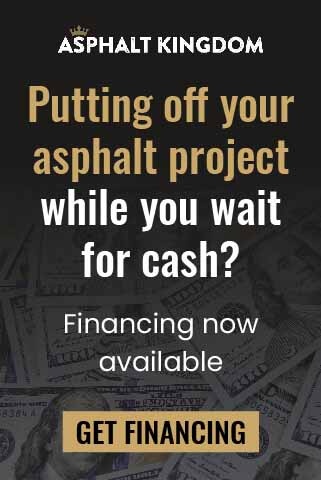Faded or oxidized asphalt is an eyesore. Keep your asphalt driveway looking fresh and brand new with these tips and suggestions!
Have you wondered why new asphalt looks rich, dark and thick, while old asphalt driveway pavement is gray, flaky and stony? That is because bitumen (tar), which mixes and holds the stones together to form asphalt, has dried out. When freshly laid, asphalt is very flexible and can withstand wear and tear. So why does asphalt turn gray? With continuous exposure to the sun, the bitumen gets eroded, and your asphalt starts to lose its deep color and flexibility.
Just like our skin, asphalt starts to fade and turn gray as it ages. This process of corrosion is called oxidation. Aged asphalt becomes brittle and prone to cracking and flaking. However, certain steps can be taken to slow down the asphalt graying process and prevent further damage to your driveway.
Warning Signs of Asphalt Deterioration
Gray asphalt is a key giveaway regarding the state of your driveway pavement. This means that the tar content that gives your asphalt its deep black color and elasticity has been completely eroded. Your driveway is now susceptible to all kinds of damage, including cracks and potholes.
Here are a few signs that your pavement needs immediate attention:
1. Faded color with visible aggregates
Due to constant exposure to the sun, rain, wind and snow, the bitumen coating of your pavement slowly disappears, leaving your pavement more vulnerable to wear and tear. Stone aggregates not only become visible, but they also start to chip off and leave uneven patches all over the surface of your pavement. This is often the beginning of a gray asphalt driveway.
2. Cracks and potholes
You don’t usually see cracks and potholes on new or fresh asphalt — unless the initial job wasn’t done properly in the first place.
When moisture seeps into the foundation of your pavement, it freezes during winter and forces its surrounding areas to expand. Once thawed, it leaves gaps in the foundation and causes the upper layer of the asphalt to cave in. These sections of chipped and crumbled aggregate form cracks on the surface of your pavement. This eventually leads to a gray asphalt driveway.
Cracks that aren’t filled soon enough grow larger and turn into potholes.
3. Vegetation growing out of cracks
Once cracks begin to appear on your driveway, weeds and other forms of vegetation follow suit. The moisture trapped inside cracks and potholes allows vegetation to thrive, which causes the asphalt to deteriorate even more. Vegetation roots that continue to grow and spread cause more damage to the foundation, leaving uneven bulges and sunken patches on the surface of your pavement.
4. Oil and chemical stains
Drips and spills from your vehicles leave stains on your graying asphalt driveway. These materials can seep into the asphalt and cause further damage if not cleaned right away.
5. Puddles and damp patches
This means that the surface of your asphalt has become uneven. Sunken sections retain water and keep it from running off. As mentioned above, trapped moisture can seep into the foundation and cause cracking and further surface damage. If you’re wondering why asphalt goes gray, this could be the root issue.
Related: Asphalt Top Coat: Learn How To Protect Your Pavement
Tips and Suggestions to Maintain Your Asphalt
Although it is impossible to prevent driveway asphalt from fading and turning gray with the passing of time, there are ways to delay the deterioration and help prolong the life of your pavement.
Here are some of our tested and proven methods in driveway maintenance:
1. Fill cracks
As soon as cracks begin to show on your asphalt’s surface, clean them thoroughly and fill them up ASAP. Cracks that grow into potholes can cause accidents. If you fill cracks the moment you notice them, you are saving time and money while helping prevent more damage and bigger issues in the long run.
Depending on the size and extent of the cracks, we have cold-pour liquid crack filler and hot-pour crack filler that would work wonders for your asphalt. For a large network of cracks that looks like a spider web or the back of an alligator, use the Gator Patch for best results.
For more information on how to identify and fill cracks properly, check out our crack repair article and our comprehensive crack repair guide for professionals.
2. Repair potholes
Potholes are larger than cracks and need to be filled with the correct material to prevent unexpected accidents and injuries. Our cold asphalt patch works best in all types of weather, which means you can fill potholes any time of the year.
Check out our pothole patching and repair guide for the step-by-step procedure.
3. Remove/clear vegetation
This step is important whether you are filling cracks and potholes or if you are in the process of sealcoating your driveway. Weeds and other small growths need to be removed before successfully cleaning or making repairs in your asphalt, as these can prevent crack filler or seal coat from properly adhering as intended. Manually pulling out weeds might be a good idea, however, if you have a long driveway or if there is too much vegetation to remove, investing in a proper leaf blower and crack cleaning machine would be more effective, especially to forestall a gray asphalt driveway.
4. Clean or remove oil and chemical stains
It is highly recommended to clean stains and spills while still fresh as they are easier to remove. A mild dish soap and warm water can do the trick for fresh stains. However, for stubborn and difficult stains, we recommend an eco-friendly biodegradable degreaser.
Check out our guide on proper stain removal from asphalt surfaces for a more in-depth walkthrough.
5. Protect your asphalt by sealcoating
Repairing cracks and potholes, cleaning stains and removing vegetation are essential to help maintain your driveway. However, if you really want to protect your asphalt surface and restore its deep color, we recommend sealcoating. A high-quality sealer helps your asphalt regain its lost flexibility and protection against exposure to the elements.
Check out our resource page and learn how to sealcoat your asphalt driveway like a pro and help prevent it from graying. Additional info on what to do after applying a fresh coat of sealer is also equally important. You can stop wondering why your asphalt goes gray.
You don’t need to spend a lot of money on contractors to maintain your asphalt driveway and avoid graying. Cleaning and sealcoating your own driveway can be a breeze so long as you know what products, tools and equipment to use.
If you have questions or are in need of further assistance, you can reach us at 1-866-399-5562 or use the form below.







-2.jpg)
-1.jpg)